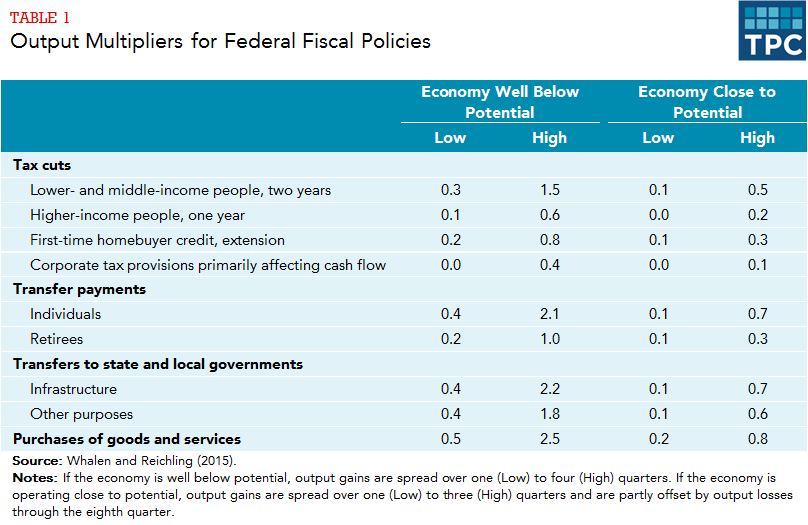Is Anyone Getting More Money From Taxes Because Of The Tax Cuts?
Taxes and curt-run demand
Economic activity reflects a balance between what people, businesses, and governments want to buy and what they want to sell. In the short run—focusing on the adjacent one or ii years—economic policy has greater impact on the need side. When the economy is weak, for example, the Federal Reserve tries to heave consumer and business demand by cut interest rates or purchasing financial securities. Congress, for its part, tin boost demand by increasing spending and cutting taxes.
Tax cuts increase household demand past increasing workers' take-habitation pay. Tax cuts tin can boost concern demand past increasing firms' later-tax cash menses, which can be used to pay dividends and expand activity, and by making hiring and investing more attractive.
MULTIPLIERS
How much taxation cuts boost demand (or tax hikes restrain it) depends on the sensitivity of household and business behavior—for instance, how households divide increased after-tax income betwixt consumption and saving, and whether businesses cull to hire and invest more. Economists summarize these furnishings in a unproblematic measure, the output multiplier, expressing how many dollars of increased economic activity event from a dollar reduction in taxes or a dollar increment in regime spending. The Congressional Budget Office (CBO) has estimated such multipliers for a mix of revenue enhancement and spending policies (table 1).

As these estimates suggest, the stimulus from taxation cuts or spending increases depends on the force of the economy. If it is operating shut to potential and the Federal Reserve is not constrained past the zero lower bound on involvement rates, financial policies will accept a small brusk-run economic effect, largely considering the Fed will offset fiscal stimulus with interest rate hikes. Notwithstanding, if the economy is far from potential and short-term interest rates are close to zero, fiscal stimulus can have significantly more touch on because the Fed will not starting time it. CBO estimates that fiscal multipliers are about three times larger when the economy is very weak than when it is strong.
CBO'south numbers illustrate substantial uncertainty in our agreement of how financial policies affect the economic system. For a two-year tax cut aimed at lower- and centre-income households, for case, CBO's low estimate of the multiplier (0.3) is simply one-fifth the size of its high approximate (1.v).
Merely some things are clear. CBO's estimates suggest that, dollar for dollar, tax cuts are often a less effective means of stimulus than are spending increases. If the federal government purchases goods and services itself (or helps country and local governments do so), near or all of the spending will boost need. If the government cuts personal taxes, however, a substantial amount of the added spending power leaks into saving. That dampening effect can be moderated by targeting tax cuts to lower- and middle-income households, which are less likely to save.
Other curt-run furnishings
Tax policies tin can likewise bear on the supply of labor in the curt run. A cut in payroll taxes could bring some workers into the labor market or encourage those already working to put in more hours. Such supply changes have little effect on output if the economy is operating well beneath potential. Nether those conditions, people have difficulty finding more than work even if they want it. If the economy is operating near potential, notwithstanding, increased labor supply can translate to increased output.
The tax policy center model
The Tax Policy Center (TPC) model of short-run economic effects differs slightly in arroyo compared to CBO'south just is designed to produce similar estimates. The CBO model estimates directly effects on demand based on generic policy types, equally in table 1. The TPC model instead derives furnishings on subsequently-tax incomes from TPC's distributional tables. TPC used this model to gauge the short-run economic and revenue effects of the Tax Cuts and Jobs Act.
Updated May 2020
Farther Reading
Congressional Budget Office. 2014. "How CBO Analyzes the Effects of Changes in Federal Fiscal Policies on the Economic system." Washington, DC: Congressional Upkeep Office.
Edelberg, Wendy. 2016. "Dynamic Analysis at CBO." Washington, DC: Congressional Budget Function.
Joint Committee on Taxation. 2015. "Macroeconomic Assay at the Articulation Commission on Revenue enhancement and the Mechanics of Its Implementation." Study JCX-3-xv. Washington, DC: Joint Commission on Taxation.
Page, Benjamin R., and Kent Smetters, 2017. "Dynamic Analysis of Tax Plans: An Update." Washington, DC: Urban-Brookings Revenue enhancement Policy Eye.
Page, Benjamin R., Joseph Rosenberg, James R. Nunns, Jeffrey Rohaly, and Daniel Berger. 2017. "Macroeconomic Analysis of the Tax Cuts and Jobs Act." Washington DC: Urban-Brookings Tax Policy Center.
Whalen, Charles J., and Felix Reichling. 2015. "The Fiscal Multiplier and Economic Policy Analysis in the United States." Working Paper 2105-two. Washington, DC: Congressional Budget Office.
Source: https://www.taxpolicycenter.org/briefing-book/how-do-taxes-affect-economy-short-run
Posted by: connersallecte.blogspot.com

0 Response to "Is Anyone Getting More Money From Taxes Because Of The Tax Cuts?"
Post a Comment